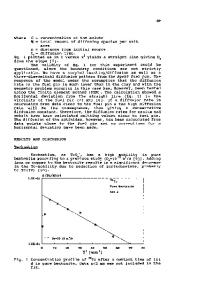Migration Behavior of Cesium in Compacted Bentonite Under Reducing Conditions Using Electromigration
- PDF / 85,339 Bytes
- 8 Pages / 612 x 792 pts (letter) Page_size
- 30 Downloads / 315 Views
Migration Behavior of Cesium in Compacted Bentonite Under Reducing Conditions Using Electromigration Kazuya Idemitsu, Masaru Yamamoto, Yosuke Yamasaki, Yaohiro Inagaki, Tatsumi Arima, Dept of Applied Quantum Physics and Nuclear Engineering, Kyushu Univ., Fukuoka, JAPAN ABSTRACT Carbon steel overpack will be corroded by consuming oxygen introduced by repository construction after closure of repository and then will keep the reducing environment in the vicinity of repository. The migration of iron corrosion products through the buffer material will affect migration of redox-sensitive radionuclides. Therefore the authors have carried out electromigration experiments with source of iron ions supplied by anode corrosion of iron coupons in compacted bentonite. However, their migration behavior was complex and difficult to explain. Thus, authors tried to use cesium, whose migration behavior is well known, in this experimental configuration to obtain knowledge of the migration behavior of cations. The concentrations of iron and sodium showed nearly complementary distributions. It is expected that iron ion could migrate as ferrous ion through the interlayer of montmorillonite replacing exchangeable sodium ions in the interlayer. On the other hand, cesium profiles seemed to be controlled by ordinary diffusion. Drift of the cesium profile by electric potential gradient could be observed clearly only after 240 h. Apparent dispersion coefficients of cesium were calculated from the profiles and were in reasonable agreement with literature values of apparent diffusion coefficients. Thus this experiment can provide a diffusion field for cations under a reducing condition with ferrous ions in water-saturated bentonite. The effect of electro-osmotic flow on ion migration was negligibly small in this experiment because electro-osmotic flow was compensated by hydraulic pressure caused by the water content gradient developed in the specimen within 24h.
INTRODUCTION Carbon steel is one of the candidate overpack materials for high-level waste disposal and is expected to assure complete containment of vitrified waste glass during an initial period of 1000 years in Japan [1]. The corrosion rate of carbon steel is reduced by the presence of buffer material such as bentonite [2,3] and seems to be affected by the diffusion of corrosive materials and corrosion products through the buffer material. Carbon steel overpack will be corroded by consuming oxygen introduced by repository construction after closure of repository and then will keep the reducing environment in the vicinity of repository. The reducing condition will be expected to retard the migration of redox-sensitive radionuclides such as uranium [4], technetium [5,6] and a few actinides [6] by lowering their solubilities and diffusivities. Therefore the authors have carried out electromigration experiments with the source of iron ions supplied by anode corrosion of iron coupons in compacted bentonite [7]. It is expected that iron ion could migrate as ferrous ion through the interlayer
Data Loading...











